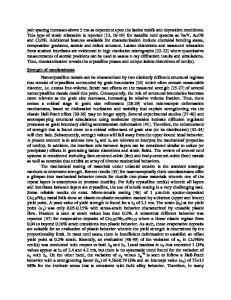Electrospinning and post-drawn processing effects on the molecular organization and mechanical properties of polyacrylon
- PDF / 2,407,212 Bytes
- 9 Pages / 612 x 792 pts (letter) Page_size
- 44 Downloads / 290 Views
esearch Letter
Electrospinning and post-drawn processing effects on the molecular organization and mechanical properties of polyacrylonitrile (PAN) nanofibers David A. Brennan, Department of Biomedical Engineering, Rowan University, 201 Mullica Hill Rd, Glassboro, NJ 08028, USA; Department of Mechanical Engineering, Rowan University, 201 Mullica Hill Rd, Glassboro, NJ 08028, USA Khosro Shirvani, Department of Mechanical Engineering, Rowan University, 201 Mullica Hill Rd, Glassboro, NJ 08028, USA Cailyn D. Rhoads, Department of Chemical Engineering, Rowan University, 201 Mullica Hill Rd, Glassboro, NJ 08028, USA Samuel E. Lofland, Department of Physics, Rowan University, 201 Mullica Hill Rd, Glassboro, NJ 08028, USA Vince Z. Beachley , Department of Biomedical Engineering, Rowan University, 201 Mullica Hill Rd, Glassboro, NJ 08028, USA Address all correspondence to Vince Z. Beachley at [email protected] (Received 7 February 2019; accepted 14 May 2019)
Abstract This paper reports the molecular organization and mechanical properties of electrospun, post-drawn polyacrylonitrile (PAN) nanofibers. Without post-drawing, the polymer chain was kinked and oriented in hexagonal crystalline structures. Immediate post-drawing in the semi-solid state disrupted the crystal structures and chain kink at maximum draw ratio. Structural re-orientation at maximum draw resulted in a 500% increase in Young’s modulus and a 100% increase in ultimate tensile strength. By applying post-drawing to electrospinning it may be possible to obtain PAN fibers and PAN-derived carbon fibers with enhanced mechanical properties compared to available fabrication technologies.
Introduction Polyacrylonitrile (PAN) is a synthetic acrylic resin which is a popular material in high-performance technologies due to several properties including thermal stability, chemical resistance, and high mechanical strength. These properties of PAN fibers make them viable for cement reinforcement, filtration, absorption, insulation, energy storage, sensors, and flame-resistant fabric. The production of synthetic carbon has been a major focus in materials science and manufacturing since 1886 when the National Carbon Company was formed. Considerable research has pursued the manufacture of carbon nanofibers for their high-performance properties including exceptional mechanical strength, electrical conductivity, thermal stability, and chemical resistance.[1] Precursor materials with a carbon backbone, such as PAN, pitch, or lignin; can be converted to carbon through a pyrolysis process, the most common method of carbon fiber manufacture. PAN is regarded as an excellent carbon fiber precursor and is the most common precursor material for carbon fiber production, utilized in approximately 90% of carbon fiber manufacture worldwide.[1] The popularity of PAN fibers is due to a higher carbon yield and stronger resultant fibers after carbonization compared to other precursor materials.[1] Furthermore, precursor PAN fibers allow a higher rate of pyrolysis and have a lower cost in comparison to other
Data Loading...











